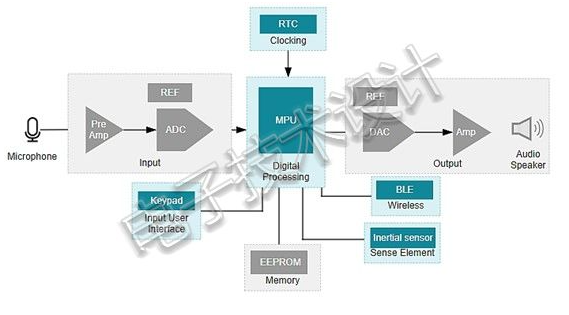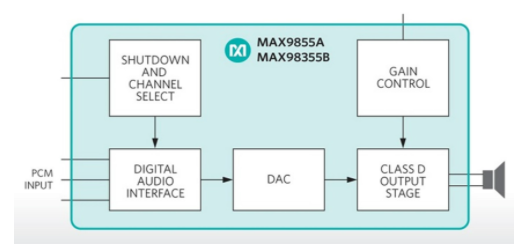Selecting an audio amplifier for smart wearable devices
Time:2022-06-04
Views:2122
"Audioamplifier" is the main component of hearabledevices (whether wired or wireless) inserted into or behind the ear.
For the design of the listening and wearing device, the analog circuit converts the sound through the microphone, amplifies and adjusts it, and then sends it to the microcontroller (MCU) to further adjust and filter the signal. Finally, the micro speaker is driven to transmit the signal to the eardrum. Digital processing based on micro processing unit (MPU) can promote the elimination of background noise and acoustic feedback, enhance speech effect, and provide automatic gain control (AGC).

The audio amplifier uses a linear mode transistor to form an output voltage, which can be said to be a scalable version of the input voltage.
Audio systems typically use class A, class B, and class AB amplifiers. However, class B and ab amplifiers are not practical choices for micro wearable devices because of their high power consumption. As long as the design engineer can ensure the operation within the linear range of the amplifier, it seems to be an ideal choice to select a class a amplifier for the pre amp that can help reduce distortion.
Class a amplifiers have low distortion and echo. The problem is that when small batteries are used, class a amplifiers have high energy consumption and small dynamic range. Therefore, the energy-efficient version of class a amplifier - class H preamplifier may be a better choice.
However, in fact, class D amplifiers are gradually becoming the best choice for listening and wearing designs. Class D amplifier, which was proposed as early as 1958, has much less power consumption than the above amplifier. As a result, class D amplifiers are more energy efficient and thus extend battery life.

More importantly, class D amplifiers do not require the use of a digital to analog converter (DAC), so they can directly drive speakers. The sound does not need to be digitally processed, so the amplified sound is clearer, more natural and more pleasant.
Class D amplifiers obviously play a crucial role in bringing more effective amplification functions to small devices such as hearing and wearing devices. Medical hearing aids are just another front line in the design of class D amplifiers, which can show their power efficiency and low noise characteristics.
For the design of the listening and wearing device, the analog circuit converts the sound through the microphone, amplifies and adjusts it, and then sends it to the microcontroller (MCU) to further adjust and filter the signal. Finally, the micro speaker is driven to transmit the signal to the eardrum. Digital processing based on micro processing unit (MPU) can promote the elimination of background noise and acoustic feedback, enhance speech effect, and provide automatic gain control (AGC).

Figure 1: the block diagram shows the basic construction module of the hearing and wearing device design. (source: texasinstruments)
The audio amplifier uses a linear mode transistor to form an output voltage, which can be said to be a scalable version of the input voltage.
Audio systems typically use class A, class B, and class AB amplifiers. However, class B and ab amplifiers are not practical choices for micro wearable devices because of their high power consumption. As long as the design engineer can ensure the operation within the linear range of the amplifier, it seems to be an ideal choice to select a class a amplifier for the pre amp that can help reduce distortion.
Class a amplifiers have low distortion and echo. The problem is that when small batteries are used, class a amplifiers have high energy consumption and small dynamic range. Therefore, the energy-efficient version of class a amplifier - class H preamplifier may be a better choice.
However, in fact, class D amplifiers are gradually becoming the best choice for listening and wearing designs. Class D amplifier, which was proposed as early as 1958, has much less power consumption than the above amplifier. As a result, class D amplifiers are more energy efficient and thus extend battery life.

Figure 2: the digital input class D amplifier makes the system design almost plug and play. (source: maximintegrated)
More importantly, class D amplifiers do not require the use of a digital to analog converter (DAC), so they can directly drive speakers. The sound does not need to be digitally processed, so the amplified sound is clearer, more natural and more pleasant.
Class D amplifiers obviously play a crucial role in bringing more effective amplification functions to small devices such as hearing and wearing devices. Medical hearing aids are just another front line in the design of class D amplifiers, which can show their power efficiency and low noise characteristics.
|
Disclaimer: This article is transferred from other platforms and does not represent the views and positions of this site. If there is infringement or objection, please contact us to delete. thank you! |











